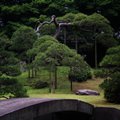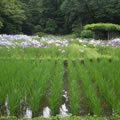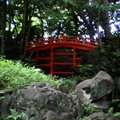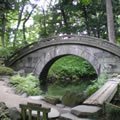Koishikawa Korakuen
Whats Nearby:
Akihabara
Downtown Tokyo
Completed in 1629, this garden is an ancient piece of old Tokyo, or Edo as it was previously named. It was created for the Tokogawa family, specifically for ruler Mitsukuni. The name "korakuen" can be translated to mean: "a garden for enjoying power, later on".
The Korakuen has many unique features, all of which can be found around the edges of the garden, as the center is somewhat boring, a large lake with an island in the center. But don't let the boring centerpiece turn you off to visiting this Garden, it does have much to offer.
Naitei
 At the far South East corner hides the true centerpiece of the Garden. A small pond, peppered with water lilies (from May to September), and an island with two small arching bridges. The island is arguably the best sculpted and designed in Tokyo. The spacing is just right, and the light comes down on the pines, illuminating them, creating quite an effect.
At the far South East corner hides the true centerpiece of the Garden. A small pond, peppered with water lilies (from May to September), and an island with two small arching bridges. The island is arguably the best sculpted and designed in Tokyo. The spacing is just right, and the light comes down on the pines, illuminating them, creating quite an effect.
This area is also home to many exotic native birds. On any given day you will find photographers taking position around the pond, hoping to capture a shot.
Rice Paddy
 A fully functional rice paddy. Every May an event is held, where public can participate in planting the rice, and then in September for the harvesting. Surrounding the rice paddy is a generous plot of iris’s, (which bloom early-mid June) the iris plot lends itself well to the this low grassy area, creating a charming clearing.
A fully functional rice paddy. Every May an event is held, where public can participate in planting the rice, and then in September for the harvesting. Surrounding the rice paddy is a generous plot of iris’s, (which bloom early-mid June) the iris plot lends itself well to the this low grassy area, creating a charming clearing.
Tsutenkyo Bridge
 In the North West corner of the Garden, while you’re meandering the stone path, you'll happen upon Tsutenkyo Bridge. Glowing in contrast to the surrounding greenery, the Tsutenkyo stands out like a beacon and lends it self well to the garden, enhancing the submersion of the experience. The bridge crosses a rocky fifty foot ravine, giving tremendous dimension and diversity to the landscape, finding dimension like this in a Tokyo garden is rare.
In the North West corner of the Garden, while you’re meandering the stone path, you'll happen upon Tsutenkyo Bridge. Glowing in contrast to the surrounding greenery, the Tsutenkyo stands out like a beacon and lends it self well to the garden, enhancing the submersion of the experience. The bridge crosses a rocky fifty foot ravine, giving tremendous dimension and diversity to the landscape, finding dimension like this in a Tokyo garden is rare.
Engetsu-kyo Bridge
 One of the surviving elements from the Edo period, the Engetsu Bridge serves as a window into the past, giving us a chance to look at a scene exactly the same as it was viewed 400 years ago. The bridge is inspired by the traditional Chinese "full moon bridge". It is called that because if you look into its reflection, you'll see the bridge's half circle roof is completed in the reflection.
One of the surviving elements from the Edo period, the Engetsu Bridge serves as a window into the past, giving us a chance to look at a scene exactly the same as it was viewed 400 years ago. The bridge is inspired by the traditional Chinese "full moon bridge". It is called that because if you look into its reflection, you'll see the bridge's half circle roof is completed in the reflection.
Events
- Garden's events include:
- Bamboo Craft Sessions (May)
- Rice Paddy Planting (May)
- Tanabata Festival (July)
- Rice Harvesting (September)
- Warabotchi Class (November)
- Snow-ropes Put on Pines (December to Februrary)
- Ume Blossom Festival (Februrary)
How to get to the Korakuen
There are over four stations surrounding the general area, but the closest one is the Oedo Line Iidabashi Station.
Admission: 300 yen
Hours: 9:00am to 5:00pm (last entry at 4:30)
Closed: Year-end holidays. (Dec 29 - Jan 1)
Related Pages





